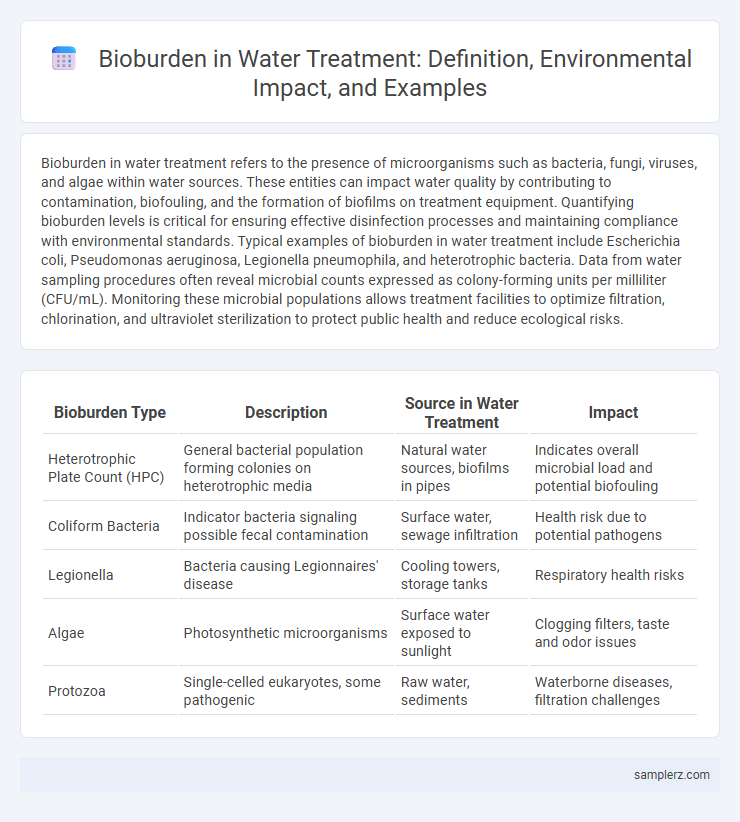Bioburden in water treatment refers to the presence of microorganisms such as bacteria, fungi, viruses, and algae within water sources. These entities can impact water quality by contributing to contamination, biofouling, and the formation of biofilms on treatment equipment. Quantifying bioburden levels is critical for ensuring effective disinfection processes and maintaining compliance with environmental standards. Typical examples of bioburden in water treatment include Escherichia coli, Pseudomonas aeruginosa, Legionella pneumophila, and heterotrophic bacteria. Data from water sampling procedures often reveal microbial counts expressed as colony-forming units per milliliter (CFU/mL). Monitoring these microbial populations allows treatment facilities to optimize filtration, chlorination, and ultraviolet sterilization to protect public health and reduce ecological risks.
Table of Comparison
| Bioburden Type | Description | Source in Water Treatment | Impact |
|---|---|---|---|
| Heterotrophic Plate Count (HPC) | General bacterial population forming colonies on heterotrophic media | Natural water sources, biofilms in pipes | Indicates overall microbial load and potential biofouling |
| Coliform Bacteria | Indicator bacteria signaling possible fecal contamination | Surface water, sewage infiltration | Health risk due to potential pathogens |
| Legionella | Bacteria causing Legionnaires' disease | Cooling towers, storage tanks | Respiratory health risks |
| Algae | Photosynthetic microorganisms | Surface water exposed to sunlight | Clogging filters, taste and odor issues |
| Protozoa | Single-celled eukaryotes, some pathogenic | Raw water, sediments | Waterborne diseases, filtration challenges |
Understanding Bioburden in Water Treatment
Bioburden in water treatment refers to the presence of microbial contaminants such as bacteria, fungi, and algae that affect water quality and safety. Common examples include biofilms formed by Pseudomonas aeruginosa and Escherichia coli colonies, which can impede filtration systems and promote corrosion in pipes. Accurate monitoring and control of bioburden levels are critical to ensuring effective disinfection processes and compliance with environmental regulations.
Common Sources of Bioburden in Water Systems
Common sources of bioburden in water treatment systems include microbial contaminants such as bacteria, algae, and fungi thriving in biofilms on pipe surfaces and storage tanks. Organic matter and nutrients from natural water sources, industrial discharge, and inadequate system maintenance contribute to microbial growth and biofilm formation. Monitoring and controlling these sources is essential to prevent contamination and ensure water quality in treatment facilities.
Types of Microorganisms Found in Water Treatment
Common types of microorganisms found in water treatment include bacteria such as Escherichia coli and Legionella, viruses like Norovirus, and protozoa including Giardia and Cryptosporidium. These pathogens contribute to bioburden, affecting the efficiency of filtration and disinfection processes. Monitoring and controlling these microbial populations through advanced treatment methods ensures water safety and compliance with health regulations.
Impact of Bioburden on Water Quality
High levels of bioburden in water treatment systems, such as bacterial colonies and biofilms, significantly degrade water quality by increasing turbidity and promoting the growth of pathogenic microorganisms. The presence of excess bioburden challenges disinfection processes, leading to elevated risks of waterborne diseases and regulatory non-compliance. Effective monitoring and control of microbial loads ensure compliance with standards like EPA and WHO guidelines, safeguarding public health and maintaining ecosystem balance.
Identifying Bioburden Hotspots in Treatment Facilities
Bioburden hotspots in water treatment facilities commonly include sedimentation tanks, filtration units, and biofilm-prone membranes where microbial accumulation leads to system inefficiencies. Identifying these hotspots requires routine microbial sampling, ATP testing, and flow cytometry analysis to detect and quantify biofilm-forming bacteria and pathogens. Targeted control measures such as periodic cleaning, disinfection protocols, and advanced monitoring systems optimize water quality by minimizing microbial contamination and ensuring regulatory compliance.
Methods for Detecting Bioburden in Water
Methods for detecting bioburden in water treatment include membrane filtration, which captures microorganisms on a filter for subsequent culturing and enumeration. ATP bioluminescence offers rapid quantification of microbial contamination by measuring intracellular adenosine triphosphate levels. Additionally, flow cytometry enables detailed analysis of microbial populations by detecting fluorescent markers indicative of cell viability and abundance.
Real-World Examples of Bioburden Contamination
Bioburden contamination in water treatment is exemplified by the presence of microbial colonies such as Pseudomonas aeruginosa and Legionella pneumophila in cooling tower systems and potable water supplies. Real-world incidents include outbreaks traced to biofilms harboring bacteria in municipal water distribution networks, leading to compromised water quality and health risks. Effective monitoring using ATP bioluminescence and microbial culture methods enables timely detection and control of bioburden to ensure safe water treatment practices.
Effective Bioburden Control Strategies
Effective bioburden control strategies in water treatment include advanced filtration methods, ultraviolet (UV) disinfection, and chlorination, which significantly reduce microbial contaminants. Implementing routine microbial monitoring and maintaining optimal operational conditions prevent pathogen proliferation and ensure water quality compliance. Integration of biofilm control techniques further enhances the removal of bacteria and organic matter from treatment systems.
Importance of Routine Monitoring in Bioburden Management
Routine monitoring of bioburden in water treatment systems is essential for maintaining water quality and preventing microbial contamination. Regular testing identifies microbial load fluctuations, enabling timely interventions that protect public health and ensure compliance with regulatory standards. Effective bioburden management minimizes risks associated with biofilm formation, corrosion, and pathogen proliferation in water distribution systems.
Case Studies: Bioburden Challenges and Solutions in Water Treatment
In water treatment, bioburden often manifests as bacterial contamination causing biofilm formation that impairs filtration systems, as seen in a case study from a municipal plant in California where high heterotrophic plate counts disrupted UV disinfection efficiency. Solutions implemented included advanced oxidation processes and periodic chlorination, which reduced microbial loads by over 90%, enhancing water quality and system longevity. This approach underscores the necessity of tailored microbial control strategies in complex water treatment infrastructures to prevent operational failures and ensure compliance with regulatory standards.

example of bioburden in water treatment Infographic
 samplerz.com
samplerz.com